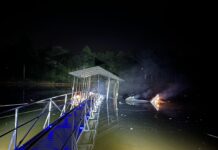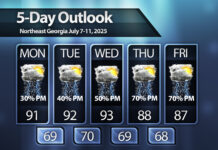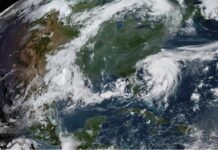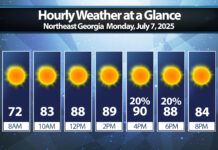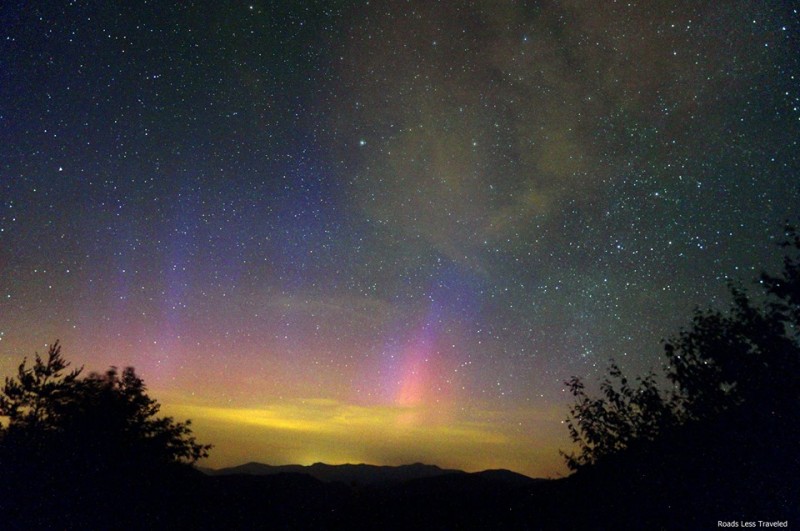
NOAA has issued a G4 (severe) geomagnetic storm alert for the second time in two days as the most significant solar storm in decades continues.
Solar flares are sending plasma into space, and millions in the continental United States were treated to a spectacular light display last night. The Aurora Borealis reached as far south as Texas and Florida Friday night, and it’s expected to be visible again this evening, Saturday, May 11.
RELATED Auroras visit North Georgia
What to look for, where and when
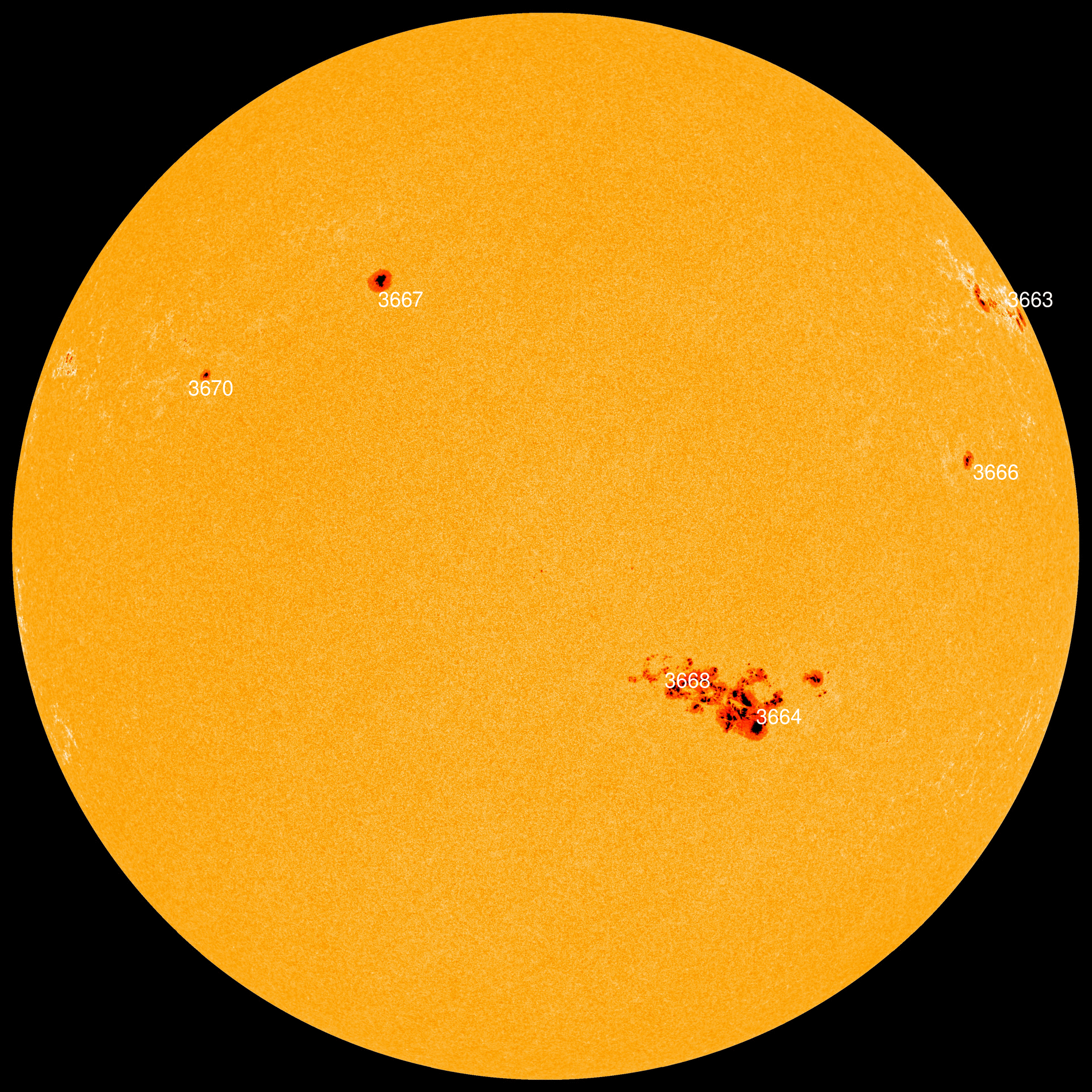
As a seasoned middle-latitude aurora chaser, here’s my guide of what to look for and what to expect.
Before we get into anything else, they are never as bright as the pictures. When I saw them for the first time from Richard Russell Highway in 2015, they were nothing more than a faint pillar of light standing against the northern horizon. Even a small amount of light pollution could have had a significant impact on visibility. Friday night was a bit of an anomaly but could easily happen again Saturday night.
Since then, I have seen them numerous times from the western NC mountains (my preferred chasing spots), and only twice were they easily noticeable against the background stars: once in 2018 and once in 2023. No matter what, you will generally need a good view of the northern horizon and dark skies. Around here, both Richard Russell Scenic Highway and Brasstown Bald offer great vantage points. Bell Mountain outside Hiawassee is also an excellent choice. There is also one overlook in Black Rock Mountain State Park that looks north and may be the best spot around, although the park closes at 10 p.m. If you are bent on having the best chance, the Blue Ridge Parkway outside Cherokee or Waynesville offers the best chance.
If you do go out, look for a dim red glow extending up from the northern horizon and some dim greenish/purple-ish pillars to the north as well. We don’t usually see green aurora in Georgia because we are viewing the tops of the green ones occurring further north.
Next, bookmark the website www.spaceweatherlive.com. This website is a great and essential tool for southern aurora chasing. You can even sign up for phone alerts to let you know what level of geomagnetic storm is currently ongoing and anytime there is a solar flare. Also, bookmark https://www.spaceweather.gov/. All the data Spaceweather Live uses is pulled directly from NOAA. All the things I talk about below can be found in the header on the NOAA website as well, I just prefer Spaceweather Live for the nice graphics so you can track changes over time.
These solar flares are the first step towards getting auroras here on Earth, as they often send bits of the sun flying off into space. These bits of sun (made of plasma, mostly charged protons and electrons) interact with our magnetic field to cause auroras. When these flares send plasma into space, we call it a Coronal Mass Ejection, or CME. You can see several of these from the past couple of days in the image below. The bright dots are Saturn and Jupiter, both on the far side of the sun right now.

We have a few indices we can use to determine whether or not these CMEs are resulting in aurora over Georgia.
KP-Index
The KP-index is the planetary K-index that indicates the geomagnetic storm intensity over a 3 hour period. It is on a scale of 0 to 9. KP-index numbers of at least 7 are necessary to get auroras this far south, but an index of 8 or 9 is preferred. Fortunately for us, the forecast from NOAA for Saturday night remains a KP index of 8.
This KP index is closely related to the G-scale that is on a scale of 1-5. A G3 storm indicates a KP index of 6 G4 storm indicates a KP index of 7-8, and a G5 storm indicates a KP index of 9. G5 storms are exceedingly rare with the last occurrence back in October of 2003. Back then, aurora were easily visible from North Georgia. This time, a G4 storm is expected which is enough to get them this far south.
Interplanetary Magnetic Field (B)
The Interplanetary Magnetic Field, listed as variable B, is the single most important thing for auroras in the middle latitudes. We really care about two parts of it: the direction and strength. On Spaceweatherlive you’ll see the strength listed as Bt and direction listed at Bz.
The strength (Bt) is measured in nanoTeslas (T) and generally runs from 20-40T during strong storms. I generally look for a strength of at least 15T to see aurora but the stronger the better. Of course, the strength means nothing if our magnetic sphere is being contrary.
The direction (Bz) is measured in both positive and negative. A positive number means things aren’t looking too great for aurora. A negative number means a “hole” has opened up in our magnetic sphere and that auroras can spill south. The lower the negative number the better for us here in North Georgia. I generally look for -15 at least but -20 or less is preferred.

Solar Wind Speed
You’ll see the solar wind speed over on Space Weather Live and this plays right into aurora chances. With this, the higher the number the better. Normally the solar wind speed runs around 300-400km/s. During strong geomagnetic storms it can increase to 700-800km/s or, rarely, even higher. There is no set number for what to look for before chasing auroras in Georgia but I personally like to see at least 600km/s before rolling out of bed.
You’ll also see particle density, which I won’t get into, but just know that the higher the number, the better.
Summary
So, to summarize what you want to see:
-KP-Index of 7+
-G-index of G4+
-Solar Wind Speed of 600km/s+
– Bt of 20nT+
– Bz of -15 or less
Keep an eye on this post and share your photos and videos with us on Now Habersham’s Facebook page.
Keep looking up!


